高中英语 新北师大版必修二 Unit 7 Lesson 1 Master pieces 教案
- 格式:docx
- 大小:22.92 KB
- 文档页数:4
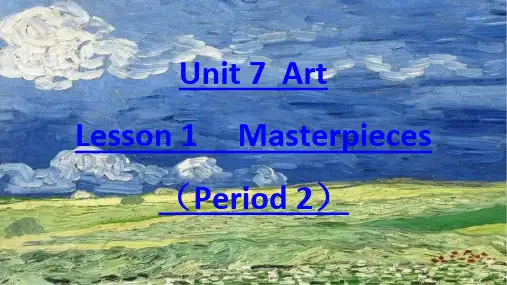
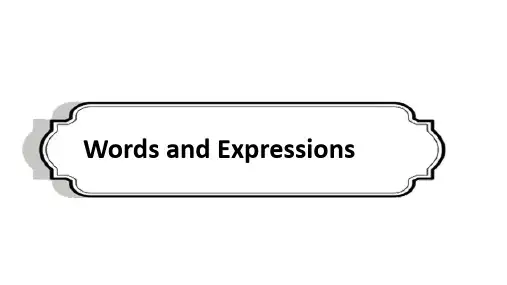
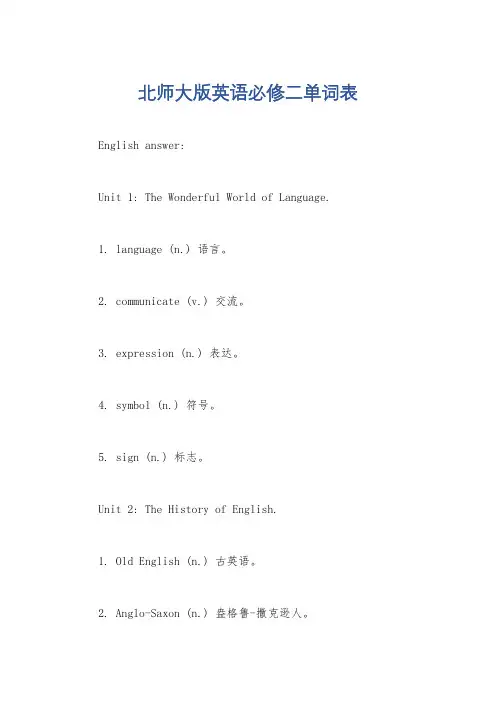
北师大版英语必修二单词表 English answer:Unit 1: The Wonderful World of Language.1. language (n.) 语言。
2. communicate (v.) 交流。
3. expression (n.) 表达。
4. symbol (n.) 符号。
5. sign (n.) 标志。
Unit 2: The History of English.1. Old English (n.) 古英语。
2. Anglo-Saxon (n.) 盎格鲁-撒克逊人。
3. Middle English (n.) 中古英语。
4. Norman (n.) 诺曼人。
5. Modern English (n.) 现代英语。
Unit 3: English Around the World.1. native speaker (n.) 母语人士。
2. official language (n.) 官方语言。
3. second language (n.) 第二语言。
4. pidgin (n.) 洋泾浜语。
5. creole (n.) 克里奥尔语。
Unit 4: The Structure of Language.1. grammar (n.) 语法。
2. noun (n.) 名词。
3. pronoun (n.) 代词。
4. verb (n.) 动词。
5. adjective (n.) 形容词。
Unit 5: The Sounds of English.1. phoneme (n.) 音素。
2. phonetics (n.) 语音学。
3. phonology (n.) 音系学。
4. stress (n.) 重音。
5. intonation (n.) 语调。
Unit 6: Vocabulary.1. vocabulary (n.) 词汇。
2. synonym (n.) 同义词。
3. antonym (n.) 反义词。
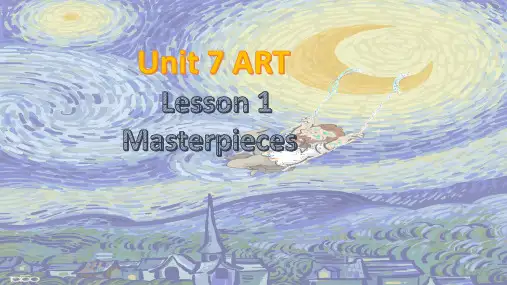
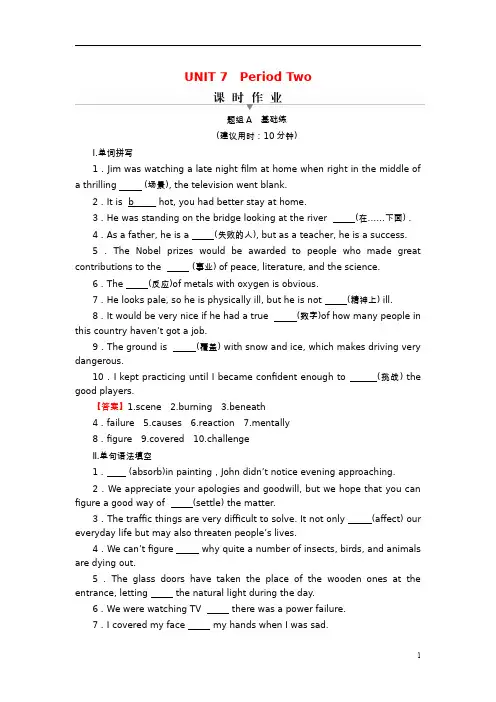
UNIT 7 Period Two题组A 基础练(建议用时:10分钟)Ⅰ.单词拼写1.Jim was watching a late night film at home when right in the middle of a thrilling (场景), the television went blank.2.It is b hot, you had better stay at home.3.He was standing on the bridge looking at the river (在……下面).4.As a father, he is a (失败的人), but as a teacher, he is a success.5.The Nobel prizes would be awarded to people who made great contributions to the (事业) of peace, literature, and the science.6.The (反应)of metals with oxygen is obvious.7.He looks pale, so he is physically ill, but he is not (精神上) ill.8.It would be very nice if he had a true (数字)of how many people in this country haven’t got a job.9.The ground is (覆盖) with snow and ice, which makes driving very dangerous.10.I kept practicing until I became confident enough to (挑战) the good players.【答案】1.scene 2.burning 3.beneath4.failure 5.causes 6.reaction 7.mentally8.figure 9.covered 10.challengeⅡ.单句语法填空1. (absorb)in painting,John didn’t notice evening approaching.2.We appreciate your apologies and goodwill, but we hope that you can figure a good way of (settle) the matter.3.The traffic things are very difficult to solve. It not only (affect) our everyday life but may also threaten people’s lives.4.We can’t figure why quite a number of insects, birds, and animals are dying out.5.The glass doors have taken the place of the wooden ones at the entrance, letting the natural light during the day.6.We were watching TV there was a power failure.7.I covered my face my hands when I was sad.8. they are most interested in is how they can produce more and better cars.9.Can you make sure Alice has put on the gold necklace?10.—Do you remember he came?—Y es, I do. He came by train.【答案】1.Absorbed 2.settling 3.affects 4.out5.in 6.when 7.with 8.What 9.that 10.howⅢ.完成句子1.She does exercise every morning to .她每天早晨做运动为了保持身材。
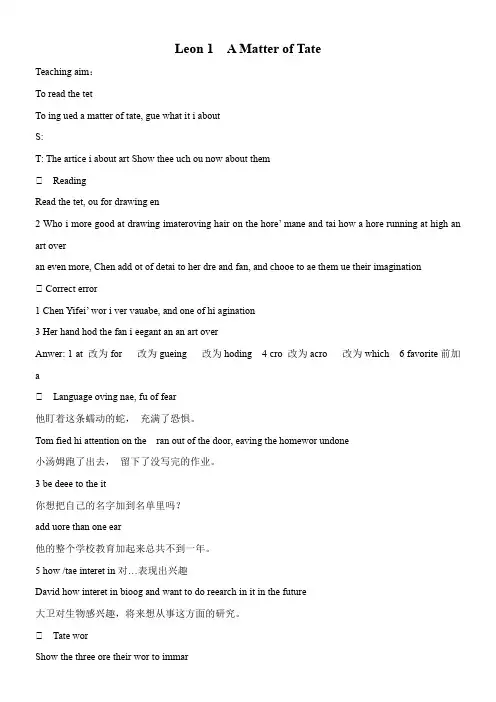
Leon 1 A Matter of TateTeaching aim:To read the tetTo ing ued a matter of tate, gue what it i aboutS:T: The artice i about art Show thee uch ou now about themⅡ ReadingRead the tet, ou for drawing en2 Who i more good at drawing imateroving hair on the hore’ mane and tai how a hore running at high an art overan even more, Chen add ot of detai to her dre and fan, and chooe to ae them ue their imaginationⅡ Correct error1 Chen Yifei’ wor i ver vauabe, and one of hi agination3 Her hand hod the fan i eegant an an art overAnwer: 1 at 改为for 改为gueing 改为hoding 4 cro 改为acro 改为which 6 favorite前加aⅡ Language oving nae, fu of fear他盯着这条蠕动的蛇,充满了恐惧。
Tom fied hi attention on the ran out of the door, eaving the homewor undone小汤姆跑了出去,留下了没写完的作业。
3 be deee to the it你想把自己的名字加到名单里吗?add uore than one ear他的整个学校教育加起来总共不到一年。
5 how /tae interet in对…表现出兴趣David how interet in bioog and want to do reearch in it in the future大卫对生物感兴趣,将来想从事这方面的研究。
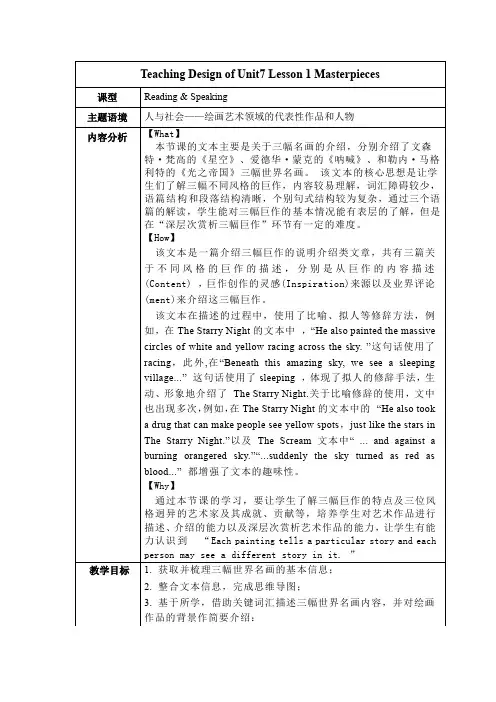
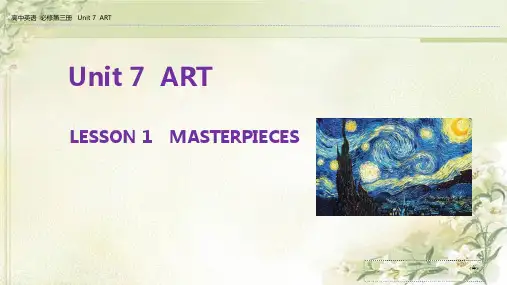
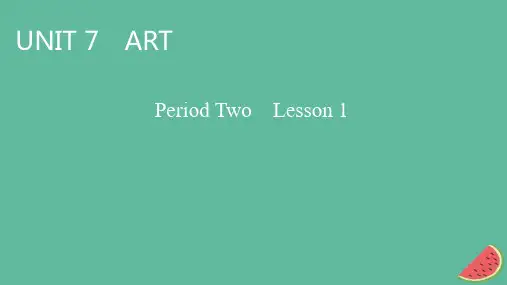
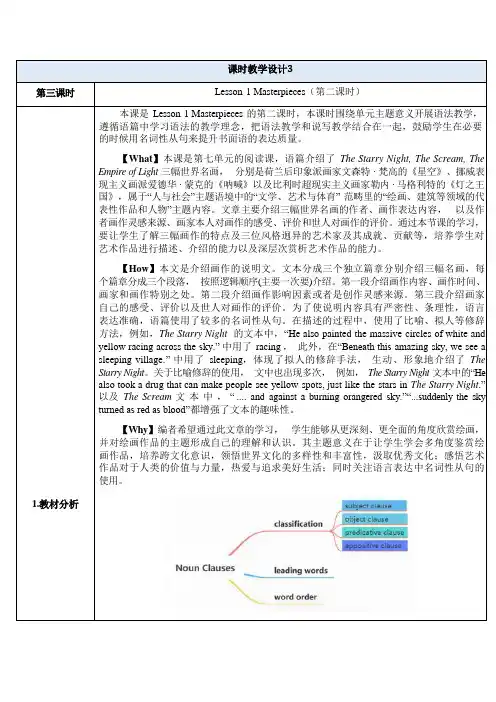
本课是Lesson 1 Masterpieces 的第二课时,本课时围绕单元主题意义开展语法教学,遵循语篇中学习语法的教学理念,把语法教学和说写教学结合在一起,鼓励学生在必要的时候用名词性从句来提升书面语的表达质量。
【What】本课是第七单元的阅读课,语篇介绍了The Starry Night, The Scream, The Empire of Light 三幅世界名画,分别是荷兰后印象派画家文森特·梵高的《星空》、挪威表现主义画派爱德华·蒙克的《呐喊》以及比利时超现实主义画家勒内·马格利特的《灯之王国》,属于“人与社会”主题语境中的“文学、艺术与体育”范畴里的“绘画、建筑等领域的代表性作品和人物”主题内容。
文章主要介绍三幅世界名画的作者、画作表达内容,以及作者画作灵感来源、画家本人对画作的感受、评价和世人对画作的评价。
通过本节课的学习,要让学生了解三幅画作的特点及三位风格迥异的艺术家及其成就、贡献等,培养学生对艺术作品进行描述、介绍的能力以及深层次赏析艺术作品的能力。
【How】本文是介绍画作的说明文。
文本分成三个独立篇章分别介绍三幅名画,每个篇章分成三个段落,按照逻辑顺序(主要一次要)介绍。
第一段介绍画作内容、画作时间、画家和画作特别之处。
第二段介绍画作影响因素或者是创作灵感来源。
第三段介绍画家自己的感受、评价以及世人对画作的评价。
为了使说明内容具有严密性、条理性,语言表达准确,语篇使用了较多的名词性从句。
在描述的过程中,使用了比喻、拟人等修辞方法,例如,The Starry Night 的文本中,“He also painted the massive circles of white and yellow racing across the sky.”中用了racing ,此外,在“Beneath this amazing sky, we see a sleeping village.”中用了sleeping,体现了拟人的修辞手法,生动、形象地介绍了The Starry Night。
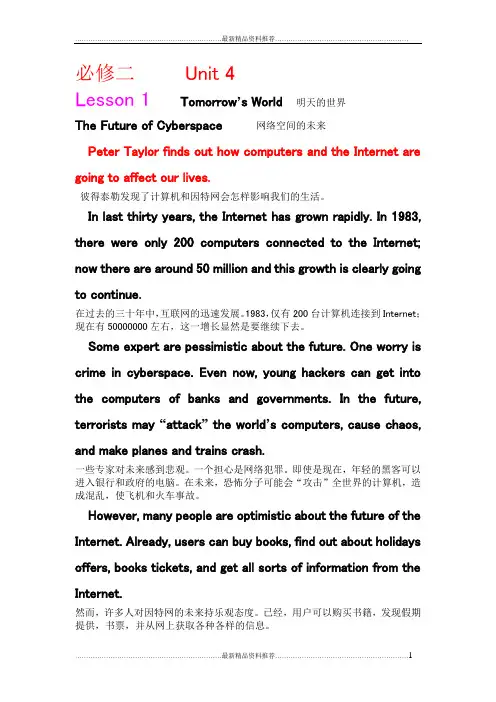
必修二Unit 4Lesson 1 Tomorrow’s World 明天的世界The Future of Cyberspace 网络空间的未来Peter Taylor finds out how computers and the Internet are going to affect our lives.彼得泰勒发现了计算机和因特网会怎样影响我们的生活。
In last thirty years, the Internet has grown rapidly. In 1983, there were only 200 computers connected to the Internet; now there are around 50 million and this growth is clearly going to continue.在过去的三十年中,互联网的迅速发展。
1983,仅有200台计算机连接到Internet;现在有50000000左右,这一增长显然是要继续下去。
Some expert are pessimistic about the future. One worry is crime in cyberspace. Even now, young hackers can get into the computers of banks and governments. In the future, terrorists may “attack” the world’s computers, cause chaos, and make planes and trains crash.一些专家对未来感到悲观。
一个担心是网络犯罪。
即使是现在,年轻的黑客可以进入银行和政府的电脑。
在未来,恐怖分子可能会“攻击”全世界的计算机,造成混乱,使飞机和火车事故。
However, many people are optimistic about the future of the Internet. Already, users can buy books, find out about holidays offers, books tickets, and get all sorts of information from the Internet.然而,许多人对因特网的未来持乐观态度。
Unit 7 ArtLesson 1 Masterpieces【教学目标】Students will be able to1. read and talk about paintings and masterpieces2. read for general understanding3. read for specific information and understanding words in context4. read for similarities between three different paintings5. learn about and practise noun clauses6. learn about and practise subject clauses, object clauses and predicative clauses【教学重难点】1. reading for specific information2. Using noun clauses in context【教学过程】1. Talk about paintings on page 8.(1) Discuss one painting at a time. Students can use the vocabulary under the paintings. What title would you give to each painting?Write the heading of each painting on the board; “The Starry Night”, “The Scream” and “The Empire of Light”. Ask students:a. What does the title say about the painting?b. What elements can be seen in the painting?c. What is your opinion of the painting? Explain.d. What emotion does the painting bring to mind?e. How does the painting make you feel?(2) As students are talking, write vocabulary words that they mention on the board. Make sure that every student has a chance to answer the questions and take part in the discussion.2. Read and find out what each painting is about.(1) In pairs, students read through the descriptions of the three paintings.(2) Instruct students to underline the title of each painting and the general sentence for each paragraph.(3) Encourage students to use the context to understand unknown terms.(4) In small groups, students discuss what each painting is about.(5) Review the answers as a class.3. Read again, take notes and talk about each painting.(1) Read and discuss the diagram:a. What does the painting show?b. What may have inspired the painter?c. What did the artist think, say or write about the painting?This may be difficult for students but they can use contextual clues.(2) Allow students time to read the full article again or call on volunteers to read the passage aloud.(3) In pairs, students complete the diagram. High level students can attempt to complete the diagram independently.(4) Discuss the answers as a class.4. Pair Work: Sort and introduce.(1) Read the phrases aloud. Explain any difficult words.(2) In pairs, students complete the table while discussing each phrase and why it applies to the painting.5. Read and find out similarities.(1) Suggest that students underline and take note of the similarities in each description as they are listening.(2) Ask students to volunteer to read the first paragraph of each description.(3) Create a class discussion on the similarities that students noticed. Encourage all students to participate. Students need to explain their opinions.6. Group Work: Discuss.(1) Discussion questions:a. What’s your opinion of the three paintings after reading the descriptions?b. Do you like or dislike them more? Give your reasons.(2) Instruct students to work independently, to write a few sentences on each painting, expressing their opinion. They can use the following vocabulary words: artistic beauty, originality, emotional, atmosphere, color scheme, dramatic, contrast, highlights, the painting makes me feeluneasy/inspired, dark and troubling, failure, powerful.7. Group Work: Introduce the paintings.(1) Divide students into small groups.(2) Each group chooses one painting and selects one person to be the scribe and write down notes for the group.(3) Each student in the group describes the painting, and provides background to the painting, the artist, the inspiration behind the painting etc. The scribe can mind map this information.(4) Each group writes at least ten complete sentences about the painting using these descriptions.(5) A volunteer from the group reads this passage to the class, role playing that he or she is introducing the painting to visitors at an art gallery.(6) The class can ask questions about the painting and members from the group can help to answer the questions.8. Pair Work: Read and answer.(1) Before starting, revise the different types of noun clauses. Students can read the Grammar Summary for Unit 7, Noun Clauses on page 94. Read through the rules and examples with the class and ensure that students understand clauses in the examples.(2) Students work in pairs to answer the questions on page 10.9. Combine two expressions to make a complete sentence.(1) Divide students into pairs.(2) Explain to students that full sentences include a subject (noun), a verb and a complete thought. Show that the shorter sentences do not make sense on their own as they are incomplete thoughts. Highlight that short sentences can be full sentences but not always.(3) Instruct students to read each sentence pair aloud and decide how to join the two expressions using a subject clause, an object clause or a predicative clause. Students need to support their answers.(4) Students write the completed sentences.10. Rewrite sentences.(1) Ask volunteer students to read the passage aloud to the class. Discuss any difficult words and terminology.(2) Ask students what the passage is about to gain a deeper understanding of the passage:a. What type of art did he create?b. What inspired his art?c. What is he famous for?(3) Let students work independently. Explain to students that they will join the two independent sentences for each number, using noun clauses. The sentences need to make sense and be a complete thought.(4) Students read their constructed sentences to their partner when complete and compare answers.11. Read the quotes and discuss.(1) In small groups ask students to answer the questions:a. How can a man paint with his brain?b. Why is painting similar to poetry? Poetry involves the beauty of words while painting involves the beauty of the world.c. How can poetry speak?d. Why is painting similar to cooking?e. How can you taste painting?(2) Ask students: What are the features of a good painting? Discuss focal point, beauty, skill of the art ist, inherent meaning, uniqueness and the artist’s intent. Read the information from the online resources to provide further information.。